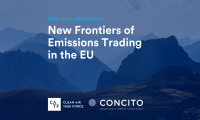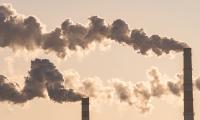Phasing out and better targeting of free allowances
- Faster phase-out of free allowances and vigilance to export rebates
- Better targeting of free allowances
- Condition allocation of free allowances on climate action
- The rules should support electrification and CCS
Today, electricity, district heating, industry, and aviation within the EU are covered by an Emissions Trading System (ETS). The system caps greenhouse gas emissions for companies by issuing a limited number of allowances. Companies must surrender one allowance for each ton of CO2 they emit. They can buy the allowances at auction and trade them freely, thus creating an allowance price. However, some allowances are allocated as free allowances to reduce the risk of competitive production moving abroad due to the allowance price. In principle, around 57% of allowances are auctioned, while around 43% are allocated as free allowances.
The rules on allocation of free allowances are important in the green transformation of industry. Free allowances must be phased out faster, better targeted, and conditional on climate action.”
The Commission has proposed to phase out free allowances by 10 percentage points per year from 2026 to 2035 for sectors (steel, iron, cement, aluminum, fertilizer, and electricity) covered by a Carbon Border Adjustment Mechanism (CBAM), while the European Parliament and the Member States have other proposals (see Figure 1). CBAM is an alternative to free allowances, as importers of goods outside the EU must pay the allowance price for the greenhouse gas emissions resulting from the production of the goods. The sectors covered by CBAM accounted for 55% of industrial greenhouse gas emissions in the EU in 2020. Currently, three Danish installations get their free allowances phased out due to CBAM. According to the Danish Government, the Commission’s proposal to phase out and target free allocation of allowances would reduce the allocation for Danish companies by 10% over the period 2021 to 2030 compared with today.
Figure 1: Proposals for phasing out free allowances for CBAM-sectors.
Free allowances are a barrier to the ‘polluter pays principle, decarbonization, and equal competition within the EU. Literature on the ETS has found limited evidence of carbon leakage. The European Court of Auditors points out that free allowances have often led to significantly slower progress in decarbonization and were not based on the companies’ ability to pass through costs to consumers. The free allocation has also led to extra profits for some sectors so far. In Denmark, free allowances contribute to an inconsistent effective carbon taxation across sectors and uses, which makes climate policy more expensive, according to the Danish Economic Councils.
CONCITO RECOMMENDS
1. Faster phase-out of free allowances and vigilance to export rebates
Free allowances can be phased out more quickly in the sectors covered by CBAM. A timeline can be established for the inclusion of other sectors in CBAM as proposed by the European Parliament, thus phasing out all free allowances over time. Concerns about the impact on industry of a faster phase-out are mitigated by the fact that the allowances resulting from the phase-out are made available to the Innovation Fund. Together with national support schemes and massive funding from the REPowerEU Plan, this can help companies on their way to decarbonisation.
The European Parliament proposes export rebates, where companies can maintain free allowances for the products they export, as CBAM does not cover exports out of the EU. Exports of products accounted for 22% of the production value in the steel industry and 6% of the production value in the cement industry in 2018.[1] However, the loss of exports is expected to be limited without export rebates,[2] and export rebates will maintain a large number of free allowances to the sectors, create greater uncertainty concerning compatibility with WTO obligations and damage the credibility of the EU’s climate policy.
[2] The Commission's impact assessment for the proposal shows that without export rebates, the export value of goods out of the EU for the sectors covered by CBAM would be reduced by 6.8% with a 10-year phase-out of free allowances and by 10-11% if free allowances were phased out immediately.
2. Better targeting of free allowances
Free allowances should be better targeted at sectors with a high risk of carbon leakage than it is today. In this context, 1) the maximum and minimum annual update rate for free allowances within each sector should be increased, 2) free allowances for electricity, biomass, and district heating should be removed, and 3) the exemption for hot metal should be abolished.[1] Today, fossil hydrogen receives free allowances, while green hydrogen via electrolysis falls outside the ETS. The solution is to phase out free allowances for fossil hydrogen by including the sector in CBAM instead of allocation free allowances to green hydrogen, so one problem is not fixed by creating another problem. If free allowances can be allocated for green hydrogen, it would potentially distribute 10 million free allowances to the sector in 2025 and 68 million free allowances in 2030, equivalent to €800 million in 2025 and €6,7 billion in 2030, which would not be available for other companies.[2]
[1] Biomass installations are not part of the ETS, as biomass counts as CO2 neutral. There has been a perverse incentive to maintain a small share of fossil consumption at the installations to stay in the system and thus receive free allowances and windfall profits. The Commission's proposal that installations where at least 95% of greenhouse gas emissions come from biomass should no longer be covered by the ETS should therefore be maintained, even though the European Parliament has removed it. The hot metal benchmark has led to overallocation of free allowances to the steel industry and should be changed to increase the minimum annual update rate within the sector from the current 0.2% per year.
[2] According to the Commission's REPowerEU Plan, the EU will produce 10 million tons of green hydrogen by 2030, equivalent to 120 GW of electrolyser capacity, and industry aims to install 17.5 GW of electrolyser capacity by 2025, equivalent to around 1.5 million tons of green hydrogen. Based on the current benchmark for hydrogen, the Commission expects 6.84 free allowances per ton of hydrogen produced. The projection of the allowance price from the Danish Ministry of Finance has been used to calculate the value of the free allowances. As a reservation, the calculation does not include the fact that smaller hydrogen installations will not be covered by the ETS. Assuming a linear phase-in of electrolyser capacity, this would potentially allocate up to 225 million free allowances to the industry from 2026 to 2030, corresponding to €21,4 billion.
3. Condition allocation of free allowances on climate action
Companies should be additionally incentivized to reduce greenhouse gas emissions and use breakthrough technologies. The European Parliament’s proposal to condition allocation of free allowances on implementation of an energy audit or certified energy management system, as well as establishment of a decarbonization plan, could be a way forward. Considerations of administrative costs can be taken into account, e.g., making the conditions dependent on the size of installations.
4. The rules should support electrification and CCS
The current rules might lead to situations where installations would partly or entirely lose their free allocation when decarbonizing their production (e.g., through electrification). The allocation of free allowances is primarily based on so-called benchmarks, where the 10% most climate efficient installations, in sectors at risk of carbon leakage, get all their greenhouse gas emissions covered by free allowances, while more emission-intensive installations do not. The following adjustments are important:
- From 2026 to 2030, benchmarks need to be reviewed and modified considering the latest data, and new benchmarks should potentially be proposed.[1] Maintaining climate efficient installations in the ETS will incentivize further greenhouse gas reductions as benchmark values are reduced. Therefore, the three least emission-intensive installations should not be excluded from the review as proposed by the European Parliament.
- Barriers to the use of technologies such as heat pumps and CCS must be removed.[2]
- The heat benchmark covers many sectors and greenhouse gas emissions. This benchmark needs to be updated to include, among other things, data for heat produced from electricity, which is not counted today.[3]
[1] The current benchmarks are based on data from 2016 to 2017, while the benchmarks from 2026 to 2030 will be based on data from 2021 and 2022, according to the European Commission. The older data is suboptimal as the data for the 10% most climate efficient installations is not being based on the latest data.
[2] Installations should be allowed to continue in the ETS if they reduce the total capacity of their combustion units below 20 MW to reduce greenhouse gas emissions (e.g., through electrification).
[3] The Commission estimates that the 10% most climate efficient installations under the heat benchmark had an emissions intensity for heat of 1.6 tons of CO2 per terajoule. However, the current benchmark value is 47.3 tons of CO2 per terajoule as it is only based on data for high-efficiency boilers using natural gas (deducted with the annual update rate), leading to overallocation of allowances.





